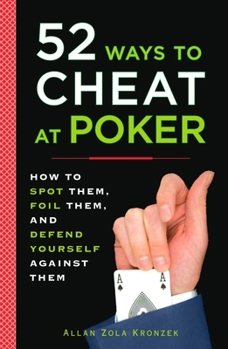52 Ways to Cheat at Poker: How to Spot Them, Foil Them, and Defend Yourself Against Them
Select Format
Select Condition 
Book Overview
Thoroughly illustrated and researched, and enlivened with historical sidebars, 52 Ways to Cheat at Poker is essential reading for anyone who plays cards for money--or anyone interested in the ingenious ways cheats steal your money while appearing to do nothing at all. It's no news that cheating pervades American culture. Americans cheat on taxes, tests, sports and spouses. But the largest arena for cheating may be at the poker...
Format:Paperback
Language:English
ISBN:0452289114
ISBN13:9780452289116
Release Date:March 2008
Publisher:Penguin Publishing Group
Length:208 Pages
Weight:0.09 lbs.
Dimensions:0.4" x 5.0" x 7.9"
Customer Reviews
5 ratings
A must if you plan to run a home game
Published by Thriftbooks.com User , 14 years ago
I bought this book as a joke. I was going to give it to a friend and tell him "this was his best chance to become a winner.....ha ha." Well, there was a local player caught cheating using techniques similar to those included in this book. He took $$$thousands. Not so funny. This book demonstrates the importance of relatively simple techniques (such as using cut cards, plastic cards, always cutting, etc.). Parts of the book are really dated and are used more for their historical value (and humor). But most of this book is a "must read" for anyone running a home game.
A terrific book!
Published by Thriftbooks.com User , 15 years ago
This is one of the best books written on poker cheating, and should be in the hands of everyone who plays for money -- from friendly Friday night games, to people who play in card rooms, to tournament pros. The author has done his homework, and gives the reader a superb education in the varied ways that hustlers and cheaters rob you of your money. Do yourself a favor and buy this book. Then read it. You will not be disappointed.
Solid, interesting, and well-written!
Published by Thriftbooks.com User , 15 years ago
Allan Kronzek tackles cheating in poker as a magician and treats the subject with a conjurer's dispassion. This is a relief; if there's one thing we don't need, it's another self-congratulatory, non-falsifiable "insider's" story of how to cheat people. Instead, we get a quick but surprisingly serious volume that manages to feed the reader some history amid the tricks. The title isn't an attempt at misdirection: after a brief introduction, Kronzek runs through 52 short chapters, each detailing one or more methods of cheating. Generally, Kronzek explains the technique involved, offers notes on historical uses, and closes by telling the reader how he can protect himself. Miscellanea scatter throughout the text, such as reproductions of cheating house catalogs and excerpts from landmark books, enliven the story. 52 Ways is written to be accessible to a novice who doesn't know a shiner from a holdout. But even veteran card mechanics could probably learn a thing or two from this book. Whatever your level of experience, reading 52 Ways will at least help you appreciate the ways that you can be cheated. That's the rub: Kronzek is honest enough to admit that no anti-cheating tactic is absolutely guaranteed. The final proof is in the pudding: if you find yourself losing one suspicious pot too many, you should suspect malfeasance. If nothing else, incorporating some of Kronzek's anti-cheating suggestions into your "friendly" home game will, at the very least, raise the bar for cheaters and help to keep honest players honest. You'll also gain a deeper appreciation for the ingenuity with which cheaters have approached poker. There's only one class of person who I'd warn away from 52 Ways: those that combine a tendency towards paranoia with an overactive imagination. If you're the kind of person who can't browse WebMD because you start imagining you have symptoms for every malady you read about, perhaps this book is not for you. By lifting the veil on cheaters and the innumerable deceptions, Kronzek has made sitting at any card table a supreme act of faith-and vigilance.
A new approach
Published by Thriftbooks.com User , 15 years ago
This book is a pleasant surprise. The author updates all of the standard cheating methods that have been described in the past, and adds many new ones that can be used in Texas hold 'em and other popular games. He also provides a context for the scams, and shows how many go back several hundred years. I doubt that anyone can learn to deal "seconds" or "bottoms" by reading this book, but that doesn't seem to be the intention. Rather, you learn what these techniques are, what they are used for--and there are several surprising uses--and what to look for during a game. The "protection tips" alone are worth the price of the book. It's also a good bedside read. Two chapters and lights out.
Very Entertaining
Published by Thriftbooks.com User , 15 years ago
After hearing the author describe some cheating methods in a radio interview, I decided to check out the book. It turns out to be a really fun read. The chapters are short and packed with information, and there are lots of amusing anecdotes. I also enjoyed the historical approach, which explains cheating methods from the days of Mississippi riverboat con-men up to the present. I have no plans to cheat anyone at poker, but I do like knowing how it's done. Great for anyone who enjoys reading about clever and devious thinking.




